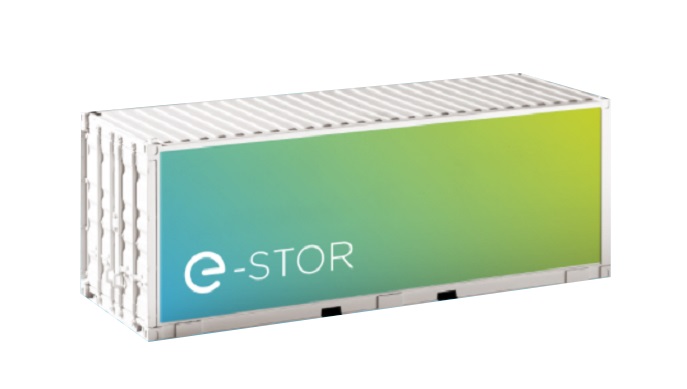The electric car market is set to see huge growth in the next few years. But what will happen to all those used car batteries further down the line?
The reuse and recycling of electric vehicle (EV) battery packs is likely to be a booming industry in the years to come. With data indicating that EVs will dominate conventional car sales as soon as 2030, components of these vehicles, including batteries, will need to be reused and recycled wherever possible. And the growing numbers of electric vehicles is also predicted to start putting a strain on the power grid in the near future.
British company Connected Energy has a solution that provides an answer to both of these concerns: their E-STOR technology takes second-life EV batteries and recycles them into power storage systems that allow for a smarter and more sustainable approach to energy use and improved grid load management. RESET talked to Connected Energy’s CEO, Matthew Lumsden, about how the technology works, the challenges and opportunities of using a circular economy approach, and where exactly those batteries finally end up.
Could you explain what your E-STOR technology is and how the idea was developed?
Our E-STOR tech is a form of stationary energy storage that uses second-life battery packs that have been taken from vehicles after the batteries have degraded. Our technology links these batteries together – as many batteries as you like, all as one. That allows us to provide the same level of service that you could get from a new system.My background is in renewables and my technical director is the former chief engineer from Lotus. As renewable power developed, it was clear to us that storage was going to be an important part of the equation. We also discovered that there were going to be quite a few electrical vehicles on the market, along with batteries, and so we began investigating and investing. Early on, we were lucky enough to win 3.5 million GBP from the UK government. We’ve now been through the process of producing a prototype, we’ve secured more funding, and we’re now selling commercial systems.
Why reuse car batteries, rather than using a different form of storage? Aside from the environmental aspects, is it because car batteries have certain properties that make them suitable for re-use?
When people started developing wind farms they were told: “Well, wind farms aren’t the solution.” But they are part of the wider solution, and it’s the same with E-STOR. The reason EV batteries are appealing is that they are relatively low cost, there is a lot of value in them, and as the global vehicle fleet switches to EVs, there’s going to be an enormous amount of them. A solution such as ours democratises energy storage, and you end up with a containerised system that can be installed at industrial sites.
Why do you only use batteries from Renault cars? Are you planning to expand to other manufacturers in the future?
The reason we started working with Renault is that the relationship with them developed fastest, but we’re currently also working with Nissan and Jaguar Land Rover too. The interesting thing about Renault is that they lease the batteries. That means if you buy a Renault EV, you can either buy or lease the battery. You buy the car, but the battery is owned by Renault, and you pay a fee for it. That gives Renault outstanding visibility on their batteries in the market, and can provide the second-life batteries as we require them.
Finding new forms of energy storage will be important for a successful and comprehensive shift to renewable energies. Who are your clients and are many of them working with renewables?
Selling storage systems is different from country to country. Incentives to do this in Germany, for example, are much more significant than in other countries. But there are other sides to the story and I personally have been astonished by the level of interest in using second-life batteries. Blue chip organisations are interested and are buying these storage solutions. That enthusiasm is unprecedented – usually the public sector is interested, but not always these companies. No doubt there’s an attachment to doing the right thing from a sustainable perspective, but if we sell storage to someone, it’s based on a business case. The driver behind energy storage is directly in response to renewable generation, and companies are also playing their part in closing the gap between load and supply. I am genuinely very heartened by the degree of interest there is from those that wish to do the right thing from a sustainability and renewable perspective.
EV batteries can have different performances at the end of their time from a car, depending on use and care. How do you manage this?
That is one of the unique aspects of our system. Our software assesses the characteristics and utilises each battery based on its state of health and state of charge. If we get a load of batteries in the system, for any particular amount of power, our algorithms determine which is the best battery to use to provide that power at any particular time. It’s very much about coping with a system between new battery and old battery and extracting the best from the entire system. Our system can handle those variations.
From cars, to power storage for utility… and then what? Can these batteries be reused again? Are you involved in any kind of recycling?
I’m not convinced there’ll be a third life for the battery, but a recycling process will involve disassembly and using parts from the battery packs to reuse for vehicles, for example. We’re working on the whole value chain with various partners – from suppliers to recyclers – to achieve this.
Copper, lithium, even the plastic inside the battery modules and system, can all be recycled and reused. Some of the work we’re doing here is pioneering – we’re looking at how to design batteries for second-life use from the outset and at how manufacturers can optimise supply chains for recycling and reusing parts, and for spares. We’re looking at the whole cycle. We’re the first in this market, so we need to build an industry around the idea of second-life, reuse, and recycling. Extending the life cycle and avoiding the depletion of earth’s resources is very important for us.
This article is part of our series Sustainable Economies and Environmental Protection with the Circular Economy, which is supported by the BMW Foundation.






